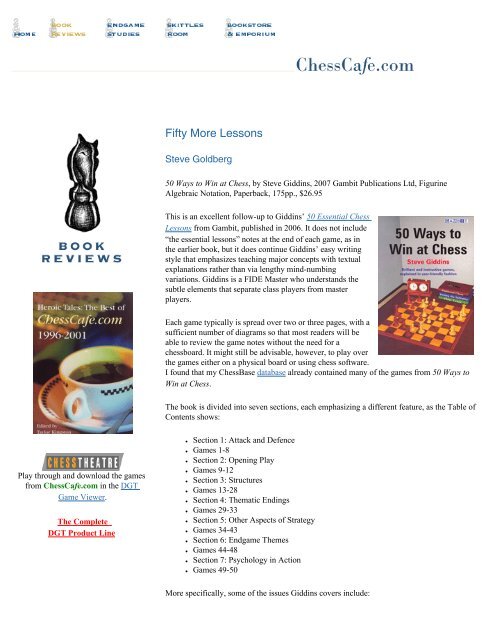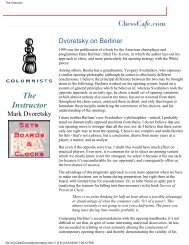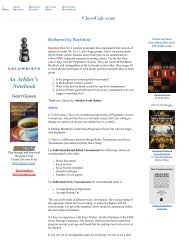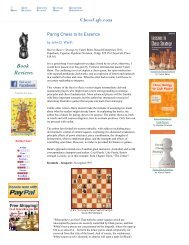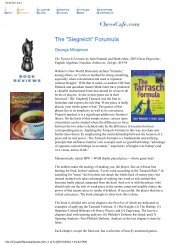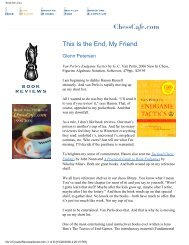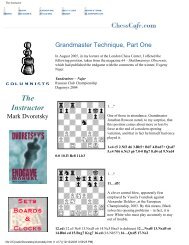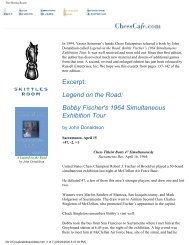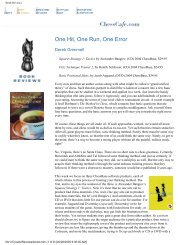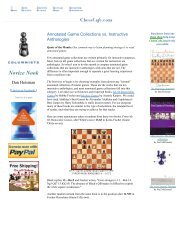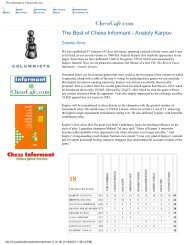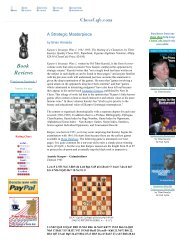Create successful ePaper yourself
Turn your PDF publications into a flip-book with our unique Google optimized e-Paper software.
Play through and download the games<br />
from <strong>Chess</strong><strong>Cafe</strong>.com in the DGT<br />
Game Viewer.<br />
The Complete<br />
DGT Product Line<br />
Fifty More Lessons<br />
Steve Goldberg<br />
<strong>50</strong> <strong>Ways</strong> <strong>to</strong> <strong>Win</strong> <strong>at</strong> <strong>Chess</strong>, by Steve Giddins, 2007 Gambit Public<strong>at</strong>ions Ltd, Figurine<br />
Algebraic Not<strong>at</strong>ion, Paperback, 175pp., $26.95<br />
This is an excellent follow-up <strong>to</strong> Giddins’ <strong>50</strong> Essential <strong>Chess</strong><br />
Lessons from Gambit, published in 2006. It does not include<br />
“the essential lessons” notes <strong>at</strong> the end of each game, as in<br />
the earlier book, but it does continue Giddins’ easy writing<br />
style th<strong>at</strong> emphasizes teaching major concepts with textual<br />
explan<strong>at</strong>ions r<strong>at</strong>her than via lengthy mind-numbing<br />
vari<strong>at</strong>ions. Giddins is a FIDE Master who understands the<br />
subtle elements th<strong>at</strong> separ<strong>at</strong>e class players from master<br />
players.<br />
Each game typically is spread over two or three pages, with a<br />
sufficient number of diagrams so th<strong>at</strong> most readers will be<br />
able <strong>to</strong> review the game notes without the need for a<br />
chessboard. It might still be advisable, however, <strong>to</strong> play over<br />
the games either on a physical board or using chess software.<br />
I found th<strong>at</strong> my <strong>Chess</strong>Base d<strong>at</strong>abase already contained many of the games from <strong>50</strong> <strong>Ways</strong> <strong>to</strong><br />
<strong>Win</strong> <strong>at</strong> <strong>Chess</strong>.<br />
The book is divided in<strong>to</strong> seven sections, each emphasizing a different fe<strong>at</strong>ure, as the Table of<br />
Contents shows:<br />
● Section 1: Attack and Defence<br />
● Games 1-8<br />
● Section 2: Opening Play<br />
● Games 9-12<br />
● Section 3: Structures<br />
● Games 13-28<br />
● Section 4: Them<strong>at</strong>ic Endings<br />
● Games 29-33<br />
● Section 5: Other Aspects of Str<strong>at</strong>egy<br />
● Games 34-43<br />
● Section 6: Endgame Themes<br />
● Games 44-48<br />
● Section 7: Psychology in Action<br />
● Games 49-<strong>50</strong><br />
More specifically, some of the issues Giddins covers include:
● The danger of a king trapped in the center<br />
● Opposite-side castling<br />
● Attacking weak color complexes<br />
● Exploiting weak opening play<br />
● Principle of two weaknesses<br />
● Pawn structure concepts<br />
● Endgame structures resulting from opening play<br />
● Exploiting the bishop-pair<br />
Game #6, from the Attack and Defense section, is Topalov-Kasparov, Euwe Memorial,<br />
Amsterdam 1995. It aptly demonstr<strong>at</strong>es Giddins’ lucid explan<strong>at</strong>ions (not all of his notes are<br />
shown):<br />
1.e4 c5 2.Nf3 Nc6 3.d4 cxd4 4.Nxd4 e6 5.Nc3 d6 6.Be3 Nf6 7.f3 Be7 8.g4 0-0 9.<br />
Qd2 a6 10.0-0-0<br />
Via a Taimanov move-order, we have<br />
transposed in<strong>to</strong> a typical Najdorf/<br />
Scheveningen Sicilian position. White’s setup,<br />
with Be3, Qd2, 0-0-0 and f3, is known as<br />
the English Attack, having been developed<br />
by the English GMs Nunn, Chandler and<br />
Short during the 1980s. It is a very direct<br />
and n<strong>at</strong>ural plan. White castles queenside,<br />
and as is typical of such opposite-castling<br />
positions, he throws his kingside pawns up<br />
<strong>to</strong> <strong>at</strong>tack the enemy king. Black, meanwhile,<br />
uses his queenside pawns and the half-open<br />
c-file <strong>to</strong> counter<strong>at</strong>tack against White’s king.<br />
Vic<strong>to</strong>ry goes <strong>to</strong> he who manages <strong>to</strong><br />
prosecute his <strong>at</strong>tack the more vigorously, with gre<strong>at</strong> accuracy being demanded of both<br />
players.<br />
10…Nxd4<br />
Black wishes <strong>to</strong> play …b5, which is impossible <strong>at</strong> once because of the undefended<br />
knight on c6, hence this exchange. He could instead defend the knight by 10…Qc7,<br />
but it is not yet clear th<strong>at</strong> c7 is the best square for the black queen. Likewise,<br />
defending the knight by 10…Bd7?! would be <strong>to</strong>o passive, since the bishop is poorly<br />
placed on d7, being both inactive itself, and also depriving Black’s king’s knight of<br />
the retre<strong>at</strong>-square on d7.<br />
11.Bxd4 b5!<br />
Continuing with his active play on the<br />
queenside. Several previous games had seen<br />
Black preface this move with 11…Nd7, but<br />
Kasparov’s choice is more energetic. The<br />
point of 11…Nd7 is th<strong>at</strong> after Kasparov’s<br />
11…b5, White could now play 12.Bxf6.<br />
Clearly, it would be bad <strong>to</strong> play 12…gxf6?,<br />
exposing Black’s king, and after 12…Bxf6,<br />
White can win a pawn by 13.Qxd6.<br />
However, Kasparov appreci<strong>at</strong>es th<strong>at</strong> Black<br />
would then have excellent compens<strong>at</strong>ion<br />
after 13…Qa5!. This type of pawn sacrifice<br />
is a common theme in the Sicilian, and
usually offers Black good counterplay. This<br />
particular version of it is especially good, as White would have serious problems<br />
meeting the thre<strong>at</strong>s of 14…Bxc3 and 14…b4, especially as 14.e5 is met by 14…Bg5+<br />
15.Kb1 b4, thre<strong>at</strong>ening 16…Rd8.<br />
12.Kb1<br />
As noted above, opposite-castling positions are usually all about a race between the<br />
opposing <strong>at</strong>tacks, with time being very much of the essence. For this reason, the textmove<br />
may appear a little slow, but it is usually necessary sooner or l<strong>at</strong>er. Black will<br />
follow up with some combin<strong>at</strong>ion of …b4 and …Qa5, after which the king move will<br />
generally be necessary <strong>to</strong> defend the a-pawn. In addition, once a black rook comes <strong>to</strong><br />
the c-file, the king will feel uncomfortable on c1.<br />
12…Bb7 13.h4 Rc8 14.g5 Nd7<br />
15.Rg1!?<br />
This is a critical moment. Both sides have<br />
deployed their forces logically and started<br />
their <strong>at</strong>tacks, and White must now decide<br />
how <strong>to</strong> continue. Clearly, White would like<br />
<strong>to</strong> play 15.h5, but this is impossible because<br />
the g5-pawn would hang, and hence the textmove.<br />
However, removing the rook from the<br />
h-file is not ideal, since in many lines, after a<br />
l<strong>at</strong>er h5 and g6, the h-file may well be<br />
opened. One typical idea for White here is<br />
the pawn sacrifice 15.g6, aiming <strong>to</strong> open<br />
lines quickly after 15…hxg6 16.h5, and if<br />
then 16…g5, 17.h6 gives White a winning <strong>at</strong>tack. In all likelihood, Black would not<br />
have captured on g6, but would have answered 15.g6 with 15…b4 16.gxh7+ Kh8.<br />
Allowing an enemy pawn <strong>to</strong> stand in front of one’s king like this is a standard<br />
defensive technique, which makes it rel<strong>at</strong>ively difficult for the <strong>at</strong>tacker <strong>to</strong> get <strong>at</strong> the<br />
black king. Even so, this may have been a better way for White <strong>to</strong> continue, since<br />
after the text-move, he soon loses the initi<strong>at</strong>ive.<br />
15…b4!<br />
Kasparov continues <strong>to</strong> prosecute his queenside play with the utmost vigour. Some<br />
earlier games had seen Black play 15…Ne5 followed by 16…Nc4. Kasparov’s plan is<br />
more straightforward, driving away the defending knight on c3. As well as furthering<br />
Black’s <strong>at</strong>tack on the white king, this has another point – <strong>to</strong> weaken White’s control<br />
of the d5-square. In such Sicilian positions, one of Black’s key str<strong>at</strong>egic ideas is <strong>to</strong><br />
achieve the break …d5 in favourable circumstances. As we shall see l<strong>at</strong>er in this<br />
game, such a break can release the potential energy of Black’s pieces, such as the<br />
bishop on e7, with gre<strong>at</strong> effect.<br />
16.Ne2 Ne5<br />
17.Rg3?!<br />
After this, Black’s initi<strong>at</strong>ive soon grows <strong>to</strong><br />
decisive proportions. Probably the best<br />
defence was 17.Bxe5 dxe5 18.Qxd8 Rfxd8,<br />
although in the resulting endgame, Black
would have a clear advantage, with his<br />
bishop-pair and control of the dark squares.<br />
17…Nc4 18.Qc1 e5!<br />
This structural change is very common in<br />
Sicilian positions. White’s pieces are in no<br />
position <strong>to</strong> exploit the weakened d5-square,<br />
and so Black is able <strong>to</strong> expand his central<br />
influence, without any downside.<br />
19.Bf2 a5<br />
It is very obvious th<strong>at</strong> White has been<br />
outplayed in the race between the two<br />
<strong>at</strong>tacks. His pieces are very awkwardly<br />
placed on the kingside, whereas Black’s<br />
position is a model of harmony. With this<br />
move, Black prepares <strong>to</strong> activ<strong>at</strong>e his lightsquared<br />
bishop along the f1-a6 diagonal, as well as setting up …a4 and …b3,<br />
breaking open White’s king position. White’s <strong>at</strong>tack on the kingside, meanwhile, is<br />
stymied.<br />
20.Bg2 Ba6 21.Re1<br />
21…Na3+ was a thre<strong>at</strong>.<br />
21…a4 22.Bh3 Rc6<br />
Now 23…b3 is thre<strong>at</strong>ened.<br />
23.Qd1<br />
23…d5!<br />
This classic central breakthrough decides m<strong>at</strong>ters in short order. Now all Black’s<br />
pieces spring in<strong>to</strong> action, and White’s back rank proves weak. Now 24.Qxd5? drops<br />
the queen after 24…Rd6 25.Qc5 Rd1+.
24.exd5 Rd6 25.f4<br />
25…Rxd5 26.Rd3<br />
The pressure down the open d-file is<br />
irresistible. 26.Qc1 loses <strong>to</strong> 26…Nd2+ 27.<br />
Ka1 Ne4 28.Rf3 Bxe2.<br />
26…Na3+!<br />
The final blow, demolishing White’s<br />
resistance.<br />
27.bxa3 Bxd3 28.cxd3 Rxd3 0-1<br />
The bishop on h3 is lost. A splendid example<br />
of how such a position can collapse if White<br />
loses the initi<strong>at</strong>ive. As Kasparov gleefully<br />
pointed out <strong>at</strong> the time, one unusual fe<strong>at</strong>ure<br />
of the game is th<strong>at</strong> Black’s queen never<br />
moved from its starting position on d8!<br />
There are fifty such games in this collection, each with something a little different <strong>to</strong><br />
contribute <strong>to</strong> the reader’s base of knowledge. In addition, each of the seven sections is<br />
introduced with illumin<strong>at</strong>ing comments. For example, in the Section 2 (“Opening Play”),<br />
Giddins clarifies th<strong>at</strong> “Many players make the mistake of thinking th<strong>at</strong> ‘knowing’ an opening<br />
just involves memorizing long sequences of moves, by rote. In reality, it is developing a<br />
deep understanding of the types of middlegame and endgame <strong>to</strong> which the opening leads,<br />
which is the key <strong>to</strong> successful play in any opening.” Giddins then presents a well-chosen<br />
game <strong>to</strong> drive home this point.<br />
<strong>50</strong> <strong>Ways</strong> <strong>to</strong> <strong>Win</strong> <strong>at</strong> <strong>Chess</strong> is another in a long line of Gambit books th<strong>at</strong> are ideally suited <strong>to</strong><br />
any class player. Giddins’ commentary is appropri<strong>at</strong>e for the lower-r<strong>at</strong>ed player who may<br />
simply want <strong>to</strong> know Why didn’t Black take the pawn?, and for the higher-r<strong>at</strong>ed player who<br />
wants <strong>to</strong> further refine his positional understanding. This is not an opening compendium, but<br />
the astute reader will deepen his appreci<strong>at</strong>ion for the various nuances of a number of<br />
openings, and more importantly, will better realize how specific openings lead <strong>to</strong> certain<br />
middlegame structures, and how these middlegame structures lead <strong>to</strong> recognizable endgame<br />
positions. Giddins even includes two games <strong>to</strong> illustr<strong>at</strong>e intangible but not uncommon<br />
psychological fac<strong>to</strong>rs <strong>at</strong> play.<br />
The <strong>at</strong>tractive cover and the clear print and diagrams are easy on the eyes, and Giddins’<br />
endless supply of insights and comfortable writing style makes this an excellent addition <strong>to</strong><br />
any player aspiring <strong>to</strong> gre<strong>at</strong>er heights.
Order <strong>50</strong> <strong>Ways</strong> <strong>to</strong> <strong>Win</strong> <strong>at</strong> <strong>Chess</strong><br />
by Steve Giddins<br />
[<strong>Chess</strong><strong>Cafe</strong> Home Page] [Book Review] [Columnists]<br />
[Endgame Study] [The Skittles Room] [Archives]<br />
[Links] [Online Books<strong>to</strong>re] [About <strong>Chess</strong><strong>Cafe</strong>.com] [Contact Us]<br />
© 2008 Cyber<strong>Cafe</strong>s, LLC. All Rights Reserved.<br />
"<strong>Chess</strong><strong>Cafe</strong>.com®" is a registered trademark of Russell Enterprises, Inc.


